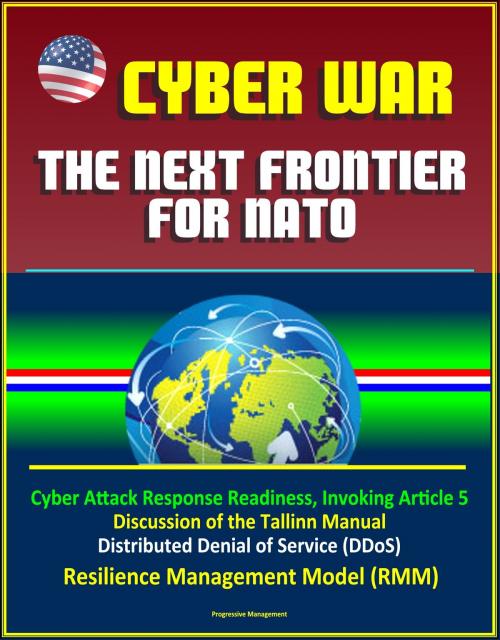Cyber War: The Next Frontier for NATO - Cyber Attack Response Readiness, Invoking Article 5, Discussion of the Tallinn Manual, Distributed Denial of Service (DDoS), Resilience Management Model (RMM)
Nonfiction, Computers, Networking & Communications, Computer Security, Operating Systems, Application Software| Author: | Progressive Management | ISBN: | 9781370462032 |
| Publisher: | Progressive Management | Publication: | December 7, 2016 |
| Imprint: | Smashwords Edition | Language: | English |
| Author: | Progressive Management |
| ISBN: | 9781370462032 |
| Publisher: | Progressive Management |
| Publication: | December 7, 2016 |
| Imprint: | Smashwords Edition |
| Language: | English |
This excellent report has been professionally converted for accurate flowing-text e-book format reproduction. Defining and understanding what constitutes a cyber-attack is a complicated matter, largely due to the fact that there has not yet been a large-scale cyber-attack upon any nation. With the help of Michael Schmitt's Tallinn Manual, published in 2013 by Cambridge University Press, it is possible to gain an understanding, although no policy expectations, of what elements need to be met for a cyber-attack to warrant a NATO response.
This study analyzes and explores the unique position that NATO operates in and the duty of NATO to protect its alliance members, and member states to protect each other. Topics discussed include how cyber-attacks are defined and identified, the particular challenges of NATO when addressing cyber-attacks, the severity of cyber-attacks, and what would need to occur in order for a victim-state to ask NATO to invoke Article 5.
This study discusses the readiness of NATO to respond to a cyber-attack and what the conditions necessary for an Article 5 response, and what that response would potentially look like. Finally, this work provides recommendations for actions that NATO could take to both prevent and confront cyber attacks.
This study is organized into six chapters. Chapter I is the introduction, providing all of the pertinent background information regarding this study and its purpose. Chapter II is a brief literature review, offering background information for the reader unfamiliar with the topic and its importance. Chapter III pertains to NATO, the history of the organization, the creation, drafting, and publishing of the Tallinn Manual, and a discussion on Articles 4 and 5 of the Washington Treaty, including why both articles are important and their invocation following 9/11. Chapter IV focuses on cyber-attacks, what they are, major international cyber-attacks, and the problems that NATO is facing in terms of responding to a cyber-attack. Chapter V explores the question of whether NATO is prepared to respond to a cyber-attack, investigates what conditions would be necessary for a cyber-attack to trigger a NATO Article 5 response and studies how NATO would respond to a cyber-attack under Article 5. Chapter V explores what conditions would need to exist if NATO were to go outside of Article 5 to respond and provides recommendations on how NATO should respond to future cyber-attacks. Chapter VI is the conclusion, including areas of understanding and unresolved issues in the current research, areas of agreement and understanding, and a discussion of unresolved issues.
This excellent report has been professionally converted for accurate flowing-text e-book format reproduction. Defining and understanding what constitutes a cyber-attack is a complicated matter, largely due to the fact that there has not yet been a large-scale cyber-attack upon any nation. With the help of Michael Schmitt's Tallinn Manual, published in 2013 by Cambridge University Press, it is possible to gain an understanding, although no policy expectations, of what elements need to be met for a cyber-attack to warrant a NATO response.
This study analyzes and explores the unique position that NATO operates in and the duty of NATO to protect its alliance members, and member states to protect each other. Topics discussed include how cyber-attacks are defined and identified, the particular challenges of NATO when addressing cyber-attacks, the severity of cyber-attacks, and what would need to occur in order for a victim-state to ask NATO to invoke Article 5.
This study discusses the readiness of NATO to respond to a cyber-attack and what the conditions necessary for an Article 5 response, and what that response would potentially look like. Finally, this work provides recommendations for actions that NATO could take to both prevent and confront cyber attacks.
This study is organized into six chapters. Chapter I is the introduction, providing all of the pertinent background information regarding this study and its purpose. Chapter II is a brief literature review, offering background information for the reader unfamiliar with the topic and its importance. Chapter III pertains to NATO, the history of the organization, the creation, drafting, and publishing of the Tallinn Manual, and a discussion on Articles 4 and 5 of the Washington Treaty, including why both articles are important and their invocation following 9/11. Chapter IV focuses on cyber-attacks, what they are, major international cyber-attacks, and the problems that NATO is facing in terms of responding to a cyber-attack. Chapter V explores the question of whether NATO is prepared to respond to a cyber-attack, investigates what conditions would be necessary for a cyber-attack to trigger a NATO Article 5 response and studies how NATO would respond to a cyber-attack under Article 5. Chapter V explores what conditions would need to exist if NATO were to go outside of Article 5 to respond and provides recommendations on how NATO should respond to future cyber-attacks. Chapter VI is the conclusion, including areas of understanding and unresolved issues in the current research, areas of agreement and understanding, and a discussion of unresolved issues.















